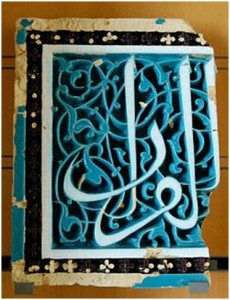CALIGRAPHY
Calligraphic design is omnipresent in Islamic art, where, as in Europe in the Middle Ages, religious exhortations, including Qur’anic verses, may be included in secular objects, especially coins, tiles and metalwork, and most painted miniatures include some script, as do many buildings. Other inscriptions include verses of poetry, and inscriptions recording ownership or donation. Two of the main scripts involved are the symbolickufic and naskh scripts, which can be found adorning and enhancing the visual appeal of the walls and domes of buildings, the sides of minbars, and metalwork.[9]
East Persian pottery from the 9th to 11th centuries decorated only with highly stylised inscriptions, called “epigraphic ware”, has been described as “probably the most refined and sensitive of all Persian pottery”.[16] Large inscriptions made from tiles, sometimes with the letters raised inrelief, or the background cut away, are found on the interiors and exteriors of many important buildings. Complex carved calligraphy also decorates buildings. For most of the Islamic period the majority of coins only showed lettering, which are often very elegant despite their small size and nature of production. The tughra or monogram of an Ottoman sultan was used extensively on official documents, with very elaborate decoration for important ones. Other single sheets of calligraphy, designed for albums, might contain short poems, Qu’ranic verses, or other texts.





